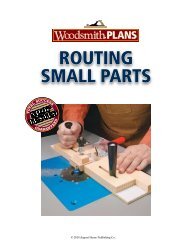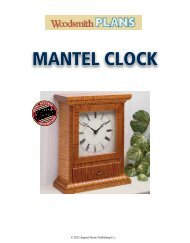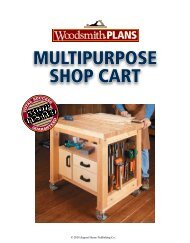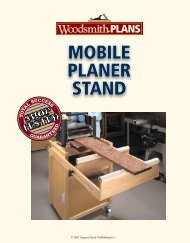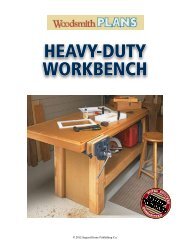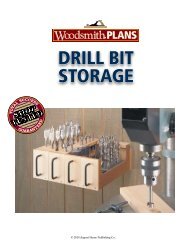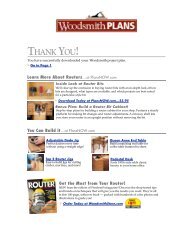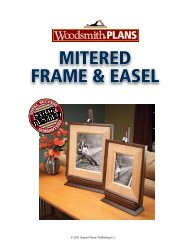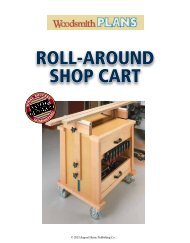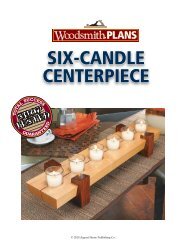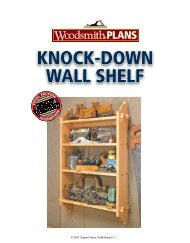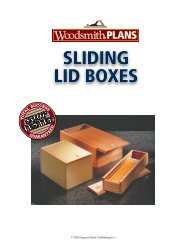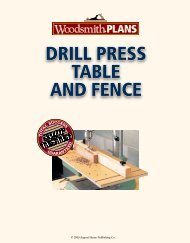CHIP-CARVED BOOK RACK - Woodsmith Shop
CHIP-CARVED BOOK RACK - Woodsmith Shop
CHIP-CARVED BOOK RACK - Woodsmith Shop
- No tags were found...
You also want an ePaper? Increase the reach of your titles
YUMPU automatically turns print PDFs into web optimized ePapers that Google loves.
chip-carvedbook rackTOTAL SUCCESSGUARANTEED© 2012 August Home Publishing Co.
Weekend Projectchip-carvedBook RackHere’s a small project with big appeal — a great look, classic joinery,and a chance to learn a simple carving technique.{ The chip-carved panels really dress up this project.And picking up the basics is surprisingly easy.There’s no rule that says a small,straightforward project can’t haveloads of detail as well as interestingwoodworking. The book rackshown above proves the point.Simple, Craftsman lines and basicjoinery provide just the right challengeto your skills. And the bestpart is that start to finish, the projectcan be completed in a few days.Don’t fret about the chip-carvedend panels. We’ll show you everythingyou need to know to masterthis traditional technique. Or, youcan simply build the book rackwith plain panels.First, the BaseThe construction breaks down asfollows: First, you build a base thatconsists of a pair of rails and a shelf.Then, identical frame-and-panelassemblies are added to the endsto “box in” the books.The Base Rails. The drawingon page 2 shows the details of1 <strong>Woodsmith</strong>Plans.com WS17134 © 2012 August Home Publishing Co. All Rights Reserved.
a. b.c. d.adding theEnd FramesWith the rails and shelf ready andwaiting, you can now turn yourattention to building the identicalframe and panel assemblies thatclose in the ends of the book rack.For me, the neat part of this jobis that the joinery here will keep<strong>Shop</strong> Tip: Tall Notchesa.A tall, auxiliary miter gauge fence allows you tohold the stile upright, and a guide block keeps itsquare to the table. Flip the workpiece side forside between cuts to center the notch.e.you on your toes, but the smallscale makes it very manageable.First, the frames. The drawingabove shows you all the detailsyou need to get started. Makingthe rail and stile frames that holdthe panels is the first step.Stub Tenon & Groove. After cuttingthe frame parts to size, you tacklethe simple stub tenon and groovejoinery, as shown in detail ‘a.’ Cuttingthe shallow grooves is the firsttask. A standard blade on the tablesaw will easily handle this job. Toend up with a centered groove, Iflipped the workpiece end-forendbetween cuts. Detail ‘b’ aboveillustrates the process.Next, I cut the mating stub tenonson the ends of the rails. Installinga dado blade on the table sawis the quickest and most accurateway to get this job done. You wantto shoot for a good snug fit in theshallow groove. This will give youa solid frame asembly. Take a lookat detail ‘c’ for guidance on this.Loose ends. The basic frame joineryis now complete, but there area couple more things to take careof before moving on to the panels.First, as you can see above, thelower rails have cutouts that mirrorthose on the side rails. You canfollow the same procedure youused before to get this done.Finally, while the frames werestill in pieces, I cut tall notches inthe ends of the stile that completethe “frame-to-rail” saddle joint.The box at lower left shows thetable saw technique I used, andthere are a couple of things to keepin mind when doing the work.There are two goals here. First,you want the notch to fit snuglyover the dado in the base rail. Andsince the top edge of the notch willsimply butt against the top of therail, you want it to be as clean andcrisp as possible. A “sneak-up-andtest-fit”approach is a good solutionto both these challenges.Next, the panels. With the notchescut, you can set the frame piecesaside and start on the panels.And if you haven’t already doneso, you now have a decision tomake. You can keep things simpleand make “plain” panels, or dressthem up with a chip carved design.I think you’ll find that thecarving technique is easy to learnand we’ll show you all the basicson page 5. Either way, the panelsstart out the same way.Since my panels were going tobe carved, I chose to make themout of soft basswood. Its light color3 <strong>Woodsmith</strong>Plans.com WS17134 © 2012 August Home Publishing Co. All Rights Reserved.
also helps highlight the simplecarving. For plain, raised panels,cherry is a good option.As you can see in detail ‘d’ onthe previous page, the panels arecut from 1 ⁄ 2 "-thick stock and have araised field on both sides. The fieldis created by cutting rabbets aroundthe perimeter of the panel. To dothis, I took the panels to the routertable. With a straight bit installed,you can easily size the “tongue” fora snug fit in the grooves and alsocut clean, smooth rabbets. The boxbelow shows the setup.Assembly. Once the panels are fitto the frames, the carving follows.It’s easier to do this before assembly.When the panels are ready,you can glue the frames together.But don’t glue the panels in place.You need to allow them to expandand contract. Finally, check out theclamping tip in the right margin.The Caps. One more addition andthe end frames are finished. Asshown at right, each one is toppedwith a beveled cap.Making this piece isn’t difficult,but there are a couple of details tonote. The inside edge of the cap issquare and it sits flush with theinside edge of the frame. The endsand outside edge are beveled, butnot at the same angle, as you cansee in details ‘a’ and ‘b.’ This differenceadds a nice visual effect.The box below shows the techniqueused to cut the two differentbevels on the table saw. And whenthe caps are ready, you can gluethem to the tops of the frames.Final assembly. Now you’re readyfor the final assembly. First, dryassemble the end frames and railsand extend the pilot holes into theframes. Then reassemble the partswith glue and install the screws.Lastly, set the shelf in place andsimply screw it down (detail ‘d’).Three coats of wiping varnishwill give the cherry a warm colorand durable finish. And all that’smissing are a few favorite books. WHow-To: Make the Raised Panels & Bevel the Capsa.b.c.d.Materials, Supplies, & Cutting DiagramA Base Rails (2) 3 ⁄ 4 x 1 ⁄ 2 - 20 3 ⁄ 4B Shelf (1) 3 ⁄ 4 x 7 3 ⁄ 4 - 17 3 ⁄ 4C End Stiles (4) 3 ⁄ 4 x 1 ⁄ 4 - 10 1 ⁄ 2D Upper End Rails (2) 3 ⁄ 4 x 1 ⁄ 4 - 5 3 ⁄ 4E Lower End Rails (2) 3 ⁄ 4 x 2 - 5 3 ⁄ 4F End Panels (2) 1 ⁄ 2 x 5 3 ⁄ 4 - 7 3 ⁄ 4G End Caps (2) 1 ⁄ 2 x 1 ⁄ 2 - 8 1 ⁄ 2• (4) #8 x 1 / 4 " Fh Woodscrews• (4) #8 x 2 1 ⁄ 4 " Fh Woodscrewsa.Panel Rabbets. After adjusting the heightof the bit to size the “tongue,” rout the panelrabbets with multiple passes.A Long Bevel. The long bevel on the capis cut with the blank on edge. Be sure touse a push block to feed the piece.The End Bevels. The 30° bevels on theends of the caps can be cut easily usingan auxiliary fence on the miter gauge.4 <strong>Woodsmith</strong>Plans.com WS17134 © 2012 August Home Publishing Co. All Rights Reserved.
techniques from our shopthe traditional art ofChip CarvingThe tools are simple and the techniques are easy to learn.But it’s the final result that’s truly impressive.CuttingKnifeStabKnifeThe thought of putting a carvingtool to wood and trying to producesomething that looks good can be alittle intimidating. Skill and years ofpractice come to mind.Fortunately, for those of us whostill want to give it a shot, there’sthe art of chip carving. This is thetechnique used on the book rackproject. Chip carving can be learnedquickly, the tools are basic, and youcan achieve great results inpretty short order.What is Chip Carving? Chip carvingis just what the name implies.Individual, V-shaped “chips” areremoved from the flat surface ofthe workpiece with angled cuts ofa knife. Your design is created byremoving a series of chips in a pattern.And the goal is to create a contrastof light and shadow betweenthe surface and the incised chips.The fact that a chip carving is completedone chip at a time makes theprocess easy to handle.The tools. A chip carving toolboxis pretty basic. One or two carvingknives and a few other accessories(sharpening stones, layout tools)are all you need.The primary tool is a shortbladedcutting knife — theupper knife shown in theleft photo. It’s responsiblefor making all the chip cuts.The stab knife, bottom knife atleft, is used to create or enhancedesigns by making simple impressionsin the wood.As you can see, the short blade ofthe cutting knife “hooks” inwardslightly in relation to the handle.This allows you to present theblade to the wood at a comfortablecutting angle. The thin bladeis honed on both sides at a veryshallow 10° angle (photo below).This narrow bevel slices throughthe wood with very little effort.A 10° Angle. A sharp cutting knifeis a must for smooth cuts. Each sideof the edge is honed at a 10° angle.5 <strong>Woodsmith</strong>Plans.com WS17134 © 2012 August Home Publishing Co. All Rights Reserved.
the Grip. The way you hold thecutting knife in your hand andpresent it to the wood is important.The top two photos at right giveyou the idea. For almost all cuts,the fingers wrap around the handlewith the thumb resting along theinside, opposing the blade.The goal of your grip is steadycontrol of the knife when makingthe cuts. As you can see, this gripallows your thumb and knuckles torest on the workpiece to help guideand steady the knife. Your handshould always be in contact withthe workpiece as the cut is made.As you can see in the bottomphoto, the grip and technique forusing the stabbing knife is a littleless sophisticated. The fingerswrap around the handle with yourthumb over the end. You simplypress the end of the blade into thewood to leave an impression.Get comfortable. Chip carving isbest done while seated. The workpiececan be lying on a bench,table, or even your lap. You’ll beconstantly turning the workpiece,sometimes even during a cut, soyou don’t want to clamp it down.making the cut. The goal of goodchip carving is to “lift” the chipwith as few cuts as possible — usuallytwo or three. The resulting cutwill look crisp and clean, comingto a sharp point at the bottom. Ofcourse this ideal cut only comeswith a little practice.The perfect angle for a cut is at65° to the surface. The resultingV-groove left by two cuts at thisHow-To: A Triangle Cutangle produces a “shadow” thatbest highlights the pattern. Again,this is the ideal and certainly isn’tcritical. If you just think of this ashalfway between 45° and 90°, you’llbe close enough.Learn A Triangle Chip. One of themost common motifs used in chipcarving designs is the triangle chip.It’s used for borders and geometricdesigns and is a “basic” techniquein chip carving. Learning a trianglechip will give you good practiceat handling the knife before tryingyour hand at a few of the othertechniques.The box below shows the threecuts needed to lift a triangle chip.I’ll just add a few tips.The layout is a row of squaresabout 3 ⁄ 16 " on each side. You’ll usetwo squares to make an elongatedtriangle. Keeping the squares smallmakes the cuts easier.All the cuts start by placing thetip of the knife at a corner of the triangle.Then you use a downwardpush and a slight forward pull to cutto the opposite corner. At the end ofthe cut the edge of the knife will beon the line and angled back towardthe starting corner.Notice that to make the secondcut in the opposite direction, you’lluse a “reverse” grip (used only forthis cut). Here the cut is made witha pushing motion.After just a little practice, you’lllift triangle chips with three quickcuts. And once you’ve mastered thiscut, you can turn the page and startwork on a complete design.Resting in the Fingers. The proper grip forthe cutting knife starts with the handle restingacross all four fingers.A Firm Foundation. With the knife grippedin the fingers, the knuckles and thumb canrest on the workpiece to steady the cut.Take A Stab. The blunt stab knife is simply“stabbed” into wood to make a short orlong (by tipping the knife) impression.First Cut. The first cut starts at the apex ofthe triangle. Push the knife down and forwarduntil the edge reaches the baseline.Second Cut. To cut the second side, you’llneed to turn the workpiece and reverseyour grip on the knife.Final Cut. Make the final cut along thebaseline using the standard grip. At the endof the cut, the chip will lift free.6 <strong>Woodsmith</strong>Plans.com WS17134 © 2012 August Home Publishing Co. All Rights Reserved.
carving aPine ConeDesignWith a basic understanding and a littlepractice under your belt, the nextstep is to carve a complete design.Carving the pine cone design usedon the book rack is really prettystraightforward. You can completealmost the entire design using twoslightly different chip cuts. Andboth are fairly easy to make. Youalso have the option of choosingfrom the three alternate designs onthe next page that rely on similartechniques.First, A pattern. Good chip carvingstarts with a sharp layout or pattern.This goes a long way towardhelping you make crisp cuts. Myanswer to this is shown in thephoto above. I copied a full-size,printed pattern (you can copythe pattern at right) and stuck itto the panel with spray adhesive.The sharp lines on a paper patternare easy to follow, plus you’ll beassured that the design is identicalon both end panels.Some simple advice. Before gettinginto the details of the carving, Iwant to give you one simple tip.As you know by now, a chip carvingdesign is made up of lots ofseparate chips. You want to tryto cut each chip as smoothly andcleanly as possible. At the sametime, don’t forget that each chip isjust a small part of the design. Sodon’t fret too much over each cut —the overall look is what’s important.The basic Cuts. As mentioned, twobasic “chip” shapes make up mostof the design. Oval and crescentshapedchips create the pine cone;long, gently curving chips representthe pine needles. But beforestarting on a finished panel, I suggestyou copy an extra pattern, glueit to a blank, and practice the cuts.It will really help you get a feel formaking the cuts smoothly.Crescents & Ovals. Figures 1 and 2below show the sequence usedto make a crescent or oval chip.The challenge is the small radiusof the curves. The trick to makinga tight turn is to stand the knifemore upright. Only the tip of theblade will be in the cut, and you’llbe able to follow the curve easier.The cut starts and ends at thesurface and reaches its deepestpoint through the middle. Thegoal is to cut deep enough to liftthe chip, without undercutting.Pine Needles. The pine needles arecreated by removing a chip with1 2347 <strong>Woodsmith</strong>Plans.com WS17134 © 2012 August Home Publishing Co. All Rights Reserved.
Pine ConeFull-Size PatternThe four chip carving designs shown hereare available on the following pages asfull-size patterns. Any of these optionaldesigns can be made using the cuts andtechniques discussed in the article.GeometricDragonflylong sweeping cuts. Figures 3 and4 give you the idea. The chip startswith a small incising cut across oneor both ends, using the tip of theknife. Then I cut the outside of thecurve, followed by the inside cut,going in the opposite direction.(The depth of cut at the tip of theneedle should be very shallow.)When cutting the needle chips,you’re simply shooting for asmooth curve. So if you wanderoff the layout line, don’t worry —just gradually steer back. You’llalso find it easier to follow the lineif you turn the workpiece as youmake the cut.Let the Chips Fall. When you’reready to tackle a finished panel,the order of the cuts really isn’t tooimportant. I started at the “stem”and worked down.I’ll offer one final piece of advice.You want the design to stand outstrongly from the background.One way to do this is by makingsure your cuts are right on the layoutline — not to the inside. Thisway the chips will be full-size andshow up better. And when youmoisten the pattern and peel it offthe panel, I bet you’ll be pleasantlysurprised at the quality of yourhandiwork. WGinkgo8 <strong>Woodsmith</strong>Plans.com WS17134 © 2012 August Home Publishing Co. All Rights Reserved.
Chip CarvingPatternsGinkgo PatternGINKOFULL SIZE PATTERN<strong>Woodsmith</strong> No. 171 Online Extras©2007 August Home Publishing. All rights reserved.9 <strong>Woodsmith</strong>Plans.com WS17134 © 2012 August Home Publishing Co. All Rights Reserved.
Chip CarvingPatternsRosette PatternROSETTEFULL SIZE PATTERN<strong>Woodsmith</strong> No. 171 Online Extras©2007 August Home Publishing. All rights reserved.10 <strong>Woodsmith</strong>Plans.com WS17134 © 2012 August Home Publishing Co. All Rights Reserved.
Chip CarvingPatternsDragonfly PatternDRAGON FLYFULL SIZE PATTERN<strong>Woodsmith</strong> No. 171 Online Extras©2007 August Home Publishing. All rights reserved.11 <strong>Woodsmith</strong>Plans.com WS17134 © 2012 August Home Publishing Co. All Rights Reserved.
Chip CarvingPatternsPine Cone PatternPINE CONEFULL SIZE PATTERN<strong>Woodsmith</strong> No. 171 Online Extras©2007 August Home Publishing. All rights reserved.12 <strong>Woodsmith</strong>Plans.com WS17134 © 2012 August Home Publishing Co. All Rights Reserved.
Raised Panel Coved Edge5%/8!/8!/2#/4!/4" radiuscove7#/4RAISED PANEL - COVED EDGE13 <strong>Woodsmith</strong>Plans.com WS17134 © 2012 August Home Publishing Co. All Rights Reserved.
Raised Panel Four Fields5%/8#/8 1&/8#/4!/8!/2#/42!%/167#/4#/8RAISED PANEL - FOUR FIELDS14 <strong>Woodsmith</strong>Plans.com WS17134 © 2012 August Home Publishing Co. All Rights Reserved.
Raised Panel Square Edge5%/84!/8!/8!/2#/47#/46!/4RAISED PANEL - SQUARE EDGE15 <strong>Woodsmith</strong>Plans.com WS17134 © 2012 August Home Publishing Co. All Rights Reserved.
Raised Panel Two Fields5%/8#/8 1&/8#/4!/8!/2#/47#/46!/4RAISED PANEL - TWO FIELDS16 <strong>Woodsmith</strong>Plans.com WS17134 © 2012 August Home Publishing Co. All Rights Reserved.



